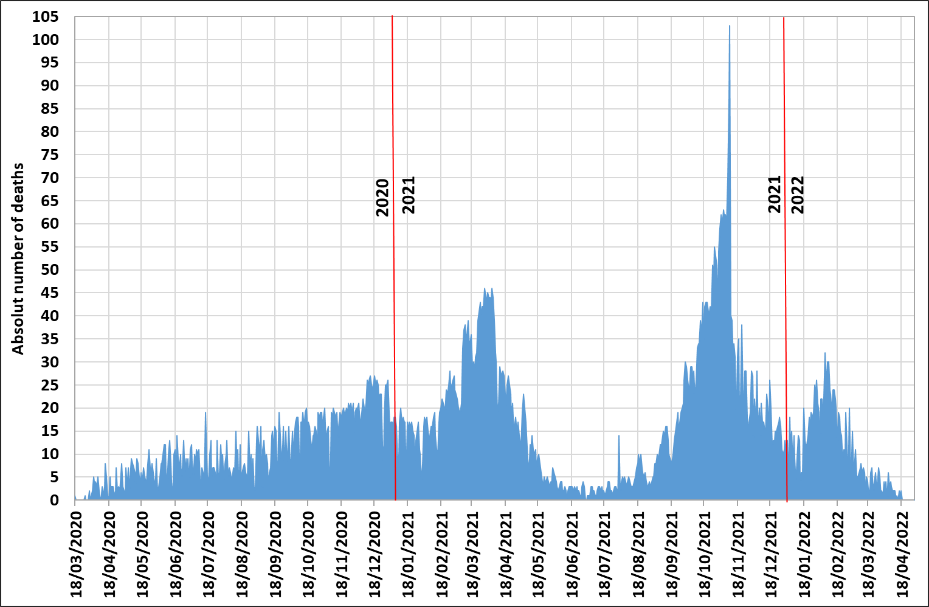
CHANGES IN MORTALITY DURING THE COVID-19 PANDEMIC IN MOLDOVA
Pahomii Irina
Center for Demographic Research, National Institute of Economic Research, Moldova . PhD student, Department of Demography and Geodemography, Faculty of Sciences, Charles University, Czech Republic
https://orcid.org/0000-0002-6595-9146, e-mail: [email protected]
DOI: https://doi.org/10.36004/nier.es.2022.2-05
JEL classification: I100, I190
UDC: 314.14(478)
Received on 12 September 2022
Accepted for publication on 6 December 2022
ACKNOWLEDGEMENTS
This study was carried out within the project 20.80009. 0807.21 «Migration, demographic changes and situation stabilization policies», 2020-2023.
Abstract. The study aims to highlight changes in mortality during the Covid-19 pandemic in Moldova. Two sources of data were used: the National Bureau of Statistics database for overall mortality and mortality by major and specific causes of death and the Ministry of Health for Covid-19 deaths. The primary analysis methods applied in the research were direct mortality standardization and the decomposition of the difference in life expectancy. The results show that the Covid-19 pandemic caused a substantial increase in the number of deaths, which lead to a significant decrease in life expectancy in both sexes. The results emphasize an increase in mortality due to diseases of the cardiovascular system and diseases of the respiratory system. The more detailed analysis of the major causes of death increased during the pandemic period showed an increase in mortality due to coronary atherosclerosis and acute pneumonia, contrary to the trends existing in the pre-pandemic period. It is important to note that mortality due to Covid-19 was higher than major leading causes of death before the pandemic period. The decomposition of changes in life expectancy between the years 2021 and 2019 by age shows quite similar age profiles between sexes, indicating the pandemic's direct and indirect impact on the dynamic of mortality. The effect of the Covid-19 pandemic on mortality, but also on the health of the population, is much more complex, requiring further research to identify prompt and effective responses.
Keywords: Covid-19, overall mortality, causes of death, Moldova
Scopul acestui studiu constă în evidențierea schimbărilor în mortalitate pe parcursul perioadei pandemice în Moldova. Cercetarea are la bază datele oficiale cu privire la numărul total de decese, dar și pe cauze de deces prezentate de Biroul Național de Statistică și numărul de decese prin Covid-19 prezentate pe pagina oficială a Ministerului Sănătății. Principalele metode de analiză aplicate în cadrul acestei cercetări au fost: metoda standardizării directe și decompoziția diferenței în speranța de viață la naștere. Rezultatele cercetării au arătat că pandemia Covid-19 a cauzat creșterea substanțială a numărului de decese, ceea ce a determinat și descreșterea speranței de viață la naștere pentru ambele sexe. S-a constatat creșterea moralității prin bolile sistemului cardiovascular și prin bolile sistemului respirator. Analiza mai detaliată a cauzelor majore de deces, ce au înregistrat creșteri pe parcursul perioadei pandemice, a reliefat creșterea mortalității prin ateroscleroză coronariană și pneumonie acută contrar trendurilor observate în perioada pre-pandemică. Trebuie să subliniem că mortalitatea prin Covid-19 a înregistrat un nivel mai înalt decât unele cauze majore de deces în perioada pre-pandemică. Decompoziția diferenței în speranța de viață la naștere între anul 2021 și 2019 pe grupe de vârste a demonstrat profile destul de asemănătoare pentru ambele sexe, ceea ce indică impactul direct și indirect al pandemiei asupra dinamicii mortalității. Evident că consecințele pandemiei Covid-19 asupra mortalității, dar și sănătății populației, sunt mult mai complexe, fiind necesare cercetări ulterioare ce ar permite identificarea unor răspunsuri prompte și eficiente.
Cuvinte cheie: Covid-19, mortalitate generală, cauze de deces, Moldova
Целью данного исследования является определение изменений смертности в период пандемии в Молдове. Исследование основывается на официальных данных Национального бюро статистики об общем количестве смертей и по причинам смерти, а также Министерства здравоохранения о количестве смертей от Covid-19. Основные методы анализа: метод прямой стандартизации и декомпозиция разницы ожидаемой продолжительности жизни при рождении. Результаты исследования показывают, что пандемия Covid-19 привела к значительному увеличению числа смертей и снижению продолжительности жизни у обоих полов. Наблюдается увеличение смертности в результате заболеваний сердечно-сосудистой и дыхательной систем. Подробный анализ основных причин смерти, увеличившихся во время пандемии, показал повышение смертности из-за коронарного атеросклероза и острой пневмонии. Важно отметить, что смертность, вызванная COVID-19, была выше даже некоторых основных причин смерти в период до пандемии. Разложение изменений в ожидаемой продолжительности жизни между 2021 и 2019 годами по возрасту показывает довольно одинаковые возрастные профили для обоих полов, что указывает на прямое и косвенное влияние пандемии на динамику смертности. Очевидно, что влияние пандемии Covid-19 на смертность, а также на здоровье населения гораздо сложнее и требует дальнейших исследований для определения оперативных и эффективных ответных мер.
Ключевые слова: влияние Covid-19, общая смертность, причины смерти, Молдова
INTRODUCTION
The Covid-19 pandemic, which had a disastrous impact on the increase in the number of deaths worldwide, caused the reversal of the evolution curves of life expectancy in most countries, with the difference in the speed of recovery of the previous positions (Aburto, et al., 2022; Islam, et al., 2021). However, the impact of the Covid-19 pandemic was different, influenced by the population age structure, and level of population health in each country. The Covid-19 pandemic affected the elderly and the segment of young adults, but with different intensities being noted between countries (Ugarte, et al., 2022). At the same time, the Covid-19 pandemic has both its direct impact, translated into deaths caused by Covid-19, and an indirect impact through the repercussions of the pandemic on the health of the population who suffered from Covid-19 (Zarei, et al., 2022) but also, the ones eventually unaffected. The structural changes brought to overall mortality during this period are of particular scientific interest.
This research aims to analyze the changes in all-cause and cause-specific mortality during the Covid-19 pandemic in Moldova compared to the pre-pandemic period assessing for differences across ages and sexes.
The actuality of the study is determined by the withdrawal of the Covid-19 pandemic and the need to highlight the structural changes determined either directly or indirectly by it, but also by the attempt to report the character of the subsequent evolution of mortality. This research aims to answer the main question – what structural changes have overall mortality undergone from the perspective of causes of death and age profile.
LITERATURE REVIEW
The impact of the Covid-19 pandemic, due to the excellence of its unexpected nature, has determined an increased need to research this phenomenon, creating response possibilities and highlighting high-risk segments and preventive measures. The research that focused on this topic was quite specific and even necessary in the initial stage of the pandemic. Later the research acquired a more pronounced demographic character, focusing on researching the impact of the Covid-19 pandemic on mortality per se. In this research, we will refer to the studies from the demographic perspective of the Covid-19 pandemic and, more precisely, its impact on the evolution of general mortality during this period. We will mainly refer to studies that analyzed changes in life expectancy and excess mortality.
Among the first to analyze the impact of the Covid-19 pandemic from a demographic perspective and underscore the excessive increases in mortality, correlating this increase with the waves of the pandemic, were the Austrian researchers Bauer et al. (Bauer, R. & Trautinger, F., 2022). In their work, the existence of regional heterogeneity was also demonstrated.
Reducing life expectancy was one of the main effects underlined in research focused on the impact of the Covid-19 pandemic on mortality. Kolk and his colleagues present a relevant study on the impact of the Covid-19 pandemic on life expectancy (Kolk, et. al., 2021). This study was referred to Sweden – a country which attracted particular attention internationally due to the position adopted regarding protective measures during the pandemic, introducing the least restrictive measures applied compared to other countries. The authors have found a reduction in life expectancy in Sweden to the level of 2017 for men and 2018 for women. At the same time, the researchers noted that in the neighbouring Nordic countries, where the virus did not spread so quickly in the initial period, no reductions in life expectancy had been observed in the first pandemic year.
The impact of the Covid-19 pandemic on premature mortality was also studied by Ugarte et al. and colleagues (cited above). Based on a comparative study, the authors pointed out that, on average, death due to Covid-19 accounts for 8.7 Potential Years of Lost Life (PYLL), but considerable variations between countries were also observed. The authors also pointed out that the most notable losses in terms of premature mortality are for people over 60 or 65 years. However, in many countries, the most significant losses occurred in younger age groups.
Research has shown that the impact of the Covid-19 pandemic in 2021 in some countries, particularly in Eastern Europe, was even more disastrous than in 2020 (Schöley, et al., 2022). However, research at the national level acknowledges that the impact of the Covid-19 pandemic on the population's health is similar to that of the developed countries most affected by it (Penina, 2020).
Penina, Mesle and Vallin (2022) have analyzed mortality trends by causes of death in Moldova from 1965 to 2020. The authors pointed out that the Covid-19 pandemic caused a significant regress in the evolution of mortality in Moldova, compromising existing trends and diminishing previous gains in mortality decline.
DATA AND METHODS
The analysis in this study is based on data on overall mortality and cause-specific deaths from the National Bureau of Statistics database. The data on mortality due to Covid-19 were retrieved from the official page of the Ministry of Health and referred to the period 18 March 2020 – 19 April 2022 (Ministry of Health of the Republic of Moldova, 2022). Data on overall mortality and by causes of death refer to the period 2014–2021, with distribution by sex and age group. Also, the values for life expectancy at birth were taken from the NBS.
The direct standardization method was used for mortality analysis, for which was applied the European Population Standard 2013 (Eurostat, 2013). Thus, mortality was analyzed based on major causes of death, but some specific causes were also analyzed.
To highlight the changes in the age structure of mortality, the decomposition of the difference in life expectancy was carried out according to Andreev's method (Andreev, 1982). The decomposition was carried out for two periods - the first denotes the structural changes from 2014-2019. The first period is a pre-pandemic one, and the second presents the evolution of mortality during the Covid-19 pandemic, the year 2019 being chosen as their dividing moment.
It is essential to mention that the data used in this research refer to the revised demographic data concerning the population with usual residence on the territory of Moldova, the left bank of the Nistru River is not included.
BACKGROUND OF THE COVID-19 PANDEMIC IN MOLDOVA
In Moldova, the first confirmed Covid-19 test was registered on 7 March 2020, while first death from Covid- 19 was registered 11 days later, on 18 March 2020 (Ministry of Health of the Republic of Moldova, 2020). The evolution of the number of deaths due to Covid-19 denotes the existence of four waves (Fig. 1). The first wave recorded in 2020 was characterized by a moderate increase in the number of deaths. This fact is determined mainly by the gradual increase in the number of Covid-19 cases and the initiation of the pandemic. In 2021, two very pronounced peaks were recorded, with rapid growth and then a sharp decline. The year 2022 can be considered a year of lowering the pandemic from its active phase, but without excluding its possible replicas, even indirectly.

Fig. 1. The number of daily COVID-19 deaths, 18/03/2020 – 18/04/2022
Source: Ministry of Health.
In the last years in Moldova, an evident trend of mortality reduction can be observed (Fig. 2). Thus, from 2014, for both sexes, a reduction in the number of deaths was observed until 2018 when a slight increase was noticed. However, in 2019 the reduction tendencies were resumed again. The pandemic years, starting with 2020, followed with an absolute and categorical increase in the number of deaths. The evolution of life expectancy is an undoubted reflection of this situation.
In males, a reduction in life expectancy by 1.6
years was recorded for 2019 and 2021, and in females by 2.2 years.
At the same time, the number of deaths in
2020 for males increased by 11.1% compared to 2019 and in 2021 by
21.4% compared to 2019; for females, there were increases of 12.6 and
28.7%, respectively. Deaths
due to Covid-19 represented 7 and 7.4% of the total deaths recorded
in 2020 for males and females, respectively, and in 2021 their share
increased to 13 and 16.6%, respectively.
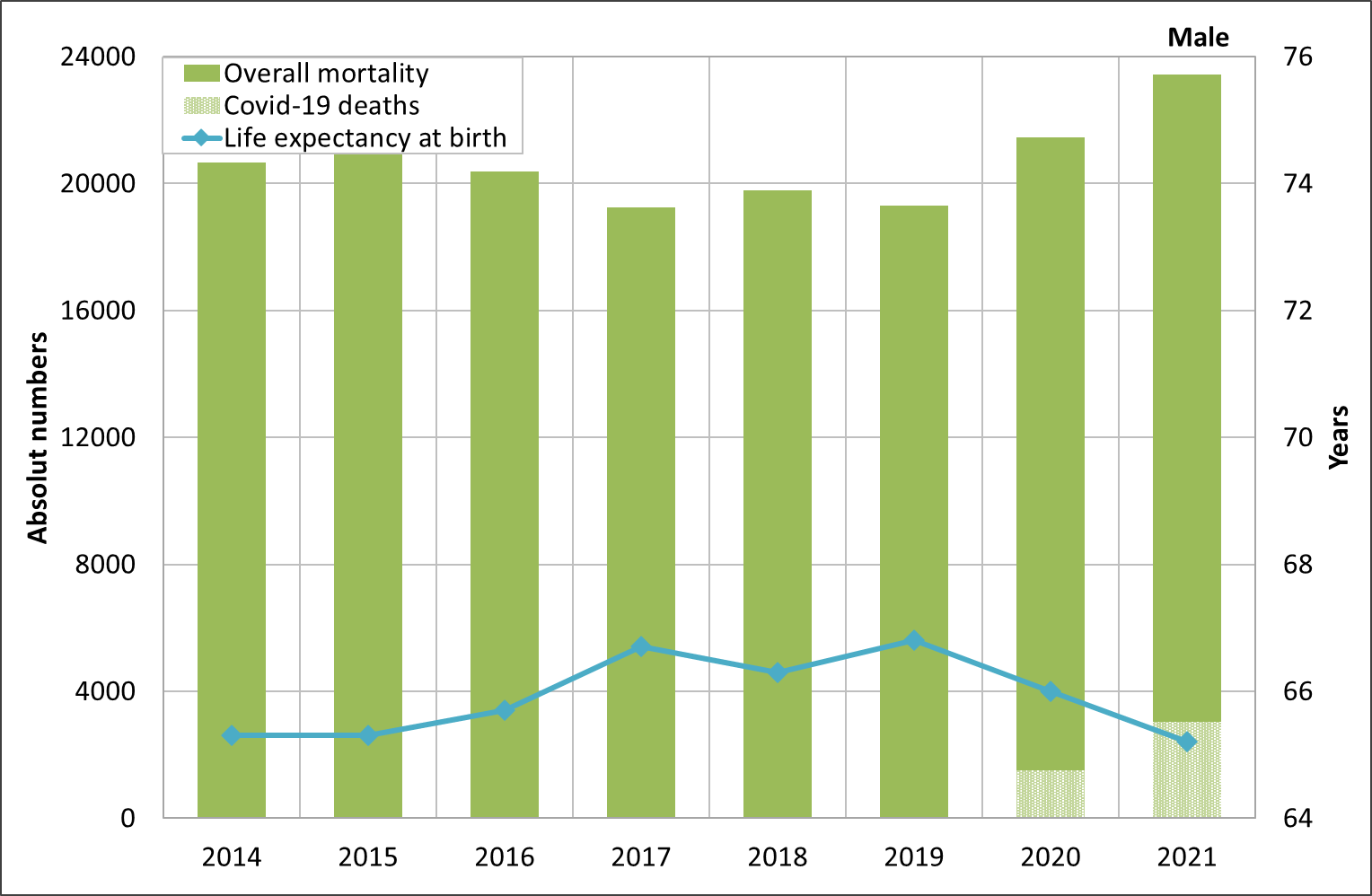
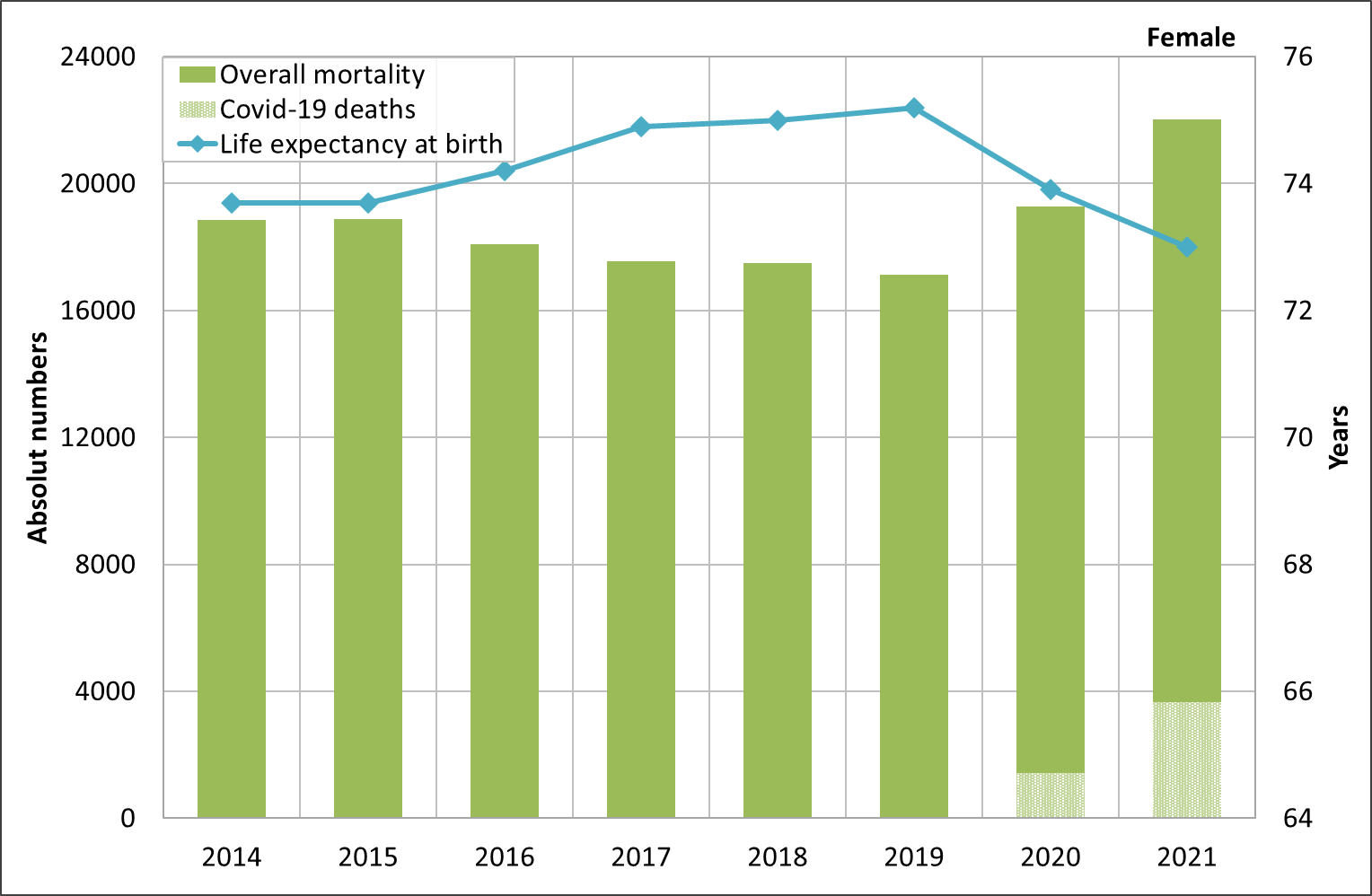
Fig. 2. Annual change in life expectancy and number of deaths for 2014–2021, by sex
Source: NBS and the Ministry of Health.
MAIN RESULTS
At the beginning of the analyzed period, in 2014, the leading three major causes of death for males were diseases of the cardiovascular system, neoplasms, and external causes (Fig. 3). Since 2015, SMR due to external causes has given way to SMR due to digestive system diseases. Thus, the top-3 major causes of death are identified with those for females - diseases of the cardiovascular system, neoplasms, and diseases of the digestive system. This hierarchy will be maintained until 2019 for both sexes. But much more critical from the perspective of the causes of death are the observed intra-causal changes. However, the pandemic period determined the interruption of the reduction in mortality due to diseases of the cardiovascular system for both sexes. The lowest value of SMR by diseases of the cardiovascular system was recorded in 2019. SMR by diseases of the cardiovascular system observed in 2021 denotes its increase by 10% for males and 7% for females. Another cause for which an increase in mortality was reported during the pandemic period is represented by diseases of the respiratory system. Thus, the SMR due to diseases of the respiratory system for males recorded in 2021 compared to its values from 2019 denotes a 13% increase in the indicator; for females, an increase in values of the SMR due to diseases of the respiratory system of 35% was noticed. Values are lower for males due to the increase in SMR due to respiratory system diseases from 2018; for females, a stable trend of reduction was followed until 2020. Another slight increase was noted for SMR due to infections, which was only observed for 2021. In 2020 still, SMR through infectious diseases followed the reduction trend.
In 2020, in the structure of the major causes of death, SMR due to Covid-19 also appeared. In 2020 SMR due to Covid-19 was very close to SMR due to diseases of the digestive system. In the following year (2021) - SMR, due to Covid-19, exceeds and outranks SMR due to diseases of the digestive system. In the case of females, the SMR due to Covid-19 in 2021 even exceeds the SMR due to neoplasms. However, the SMR due to Covid-19 is higher for males than for females – 1.5 times in 2020 and 1.3 times in 2021.


Fig. 3. Standardized mortality rate by major causes of death and Covid-19 by sex, 2014-2021
Source: Calculated based on NBS data
To understand the source of the increase in the major causes of death (through diseases of the cardiovascular system and diseases of the respiratory system), some specific, narrower causes were also analyzed (Fig. 4). Thus, the increase in mortality from diseases of the respiratory system for both sexes is mainly due to the increase in mortality from acute pneumonia. SMR by acute pneumonia until 2019 registered a stable level with insignificant oscillations for both males and females. In 2021, compared to 2019, SMR by acute pneumonia registered an increase of 34% for males and 89% for females. Increases were also noted in mortality from coronary atherosclerosis. For males, an increase in SMR due to coronary atherosclerosis is observed in both years of the pandemic, with a 33% increase recorded in 2021 compared to 2019. For females the increase was fragmentary. In 2020 an increase in mortality due to coronary atherosclerosis was highlighted, after which it was reduced; precisely because of this, the reporting of 2021 to 2019 shows an increase of 9%.


Fig. 4. Standardized mortality rate for specific minor causes of death by sex, 2014-2021
Source: Calculated based on NBS data
The age structure of mortality represents another critical aspect. For the age structure analysis, the contribution of age groups to the formation of the difference in life expectancy was analyzed. For this exercise, two-time intervals were chosen with a standard reporting point – the year 2019 (Fig. 5). In 2014-2019, life expectancy for males increased by 1.6 years and for females by 1.5 years. During the pandemic, the reduction in life expectancy for males returned this indicator to the level of 2014; for females, the reduction was more significant, thus compromising the gains obtained over time and the return to a lower level of life expectancy than in 2014.
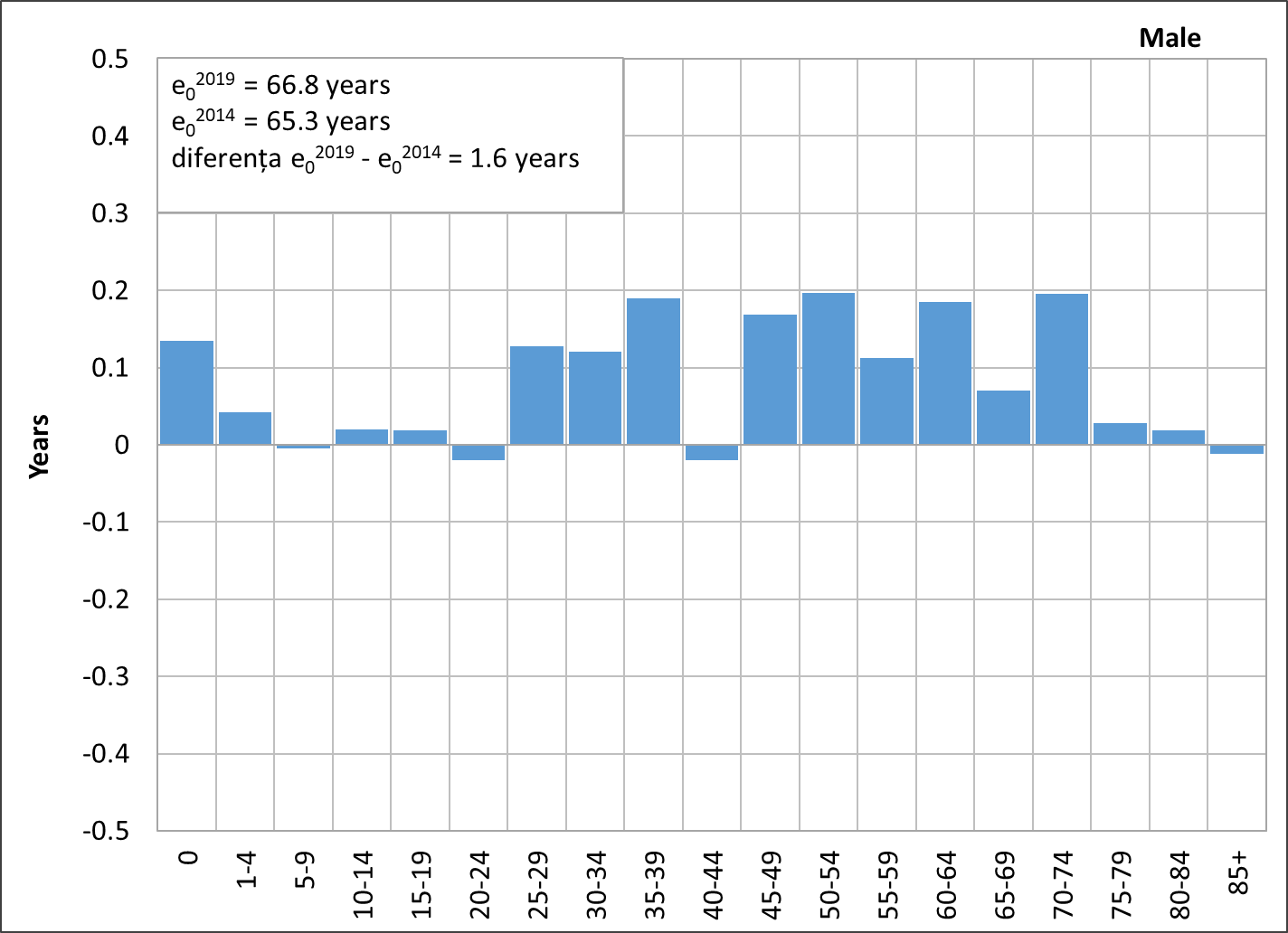
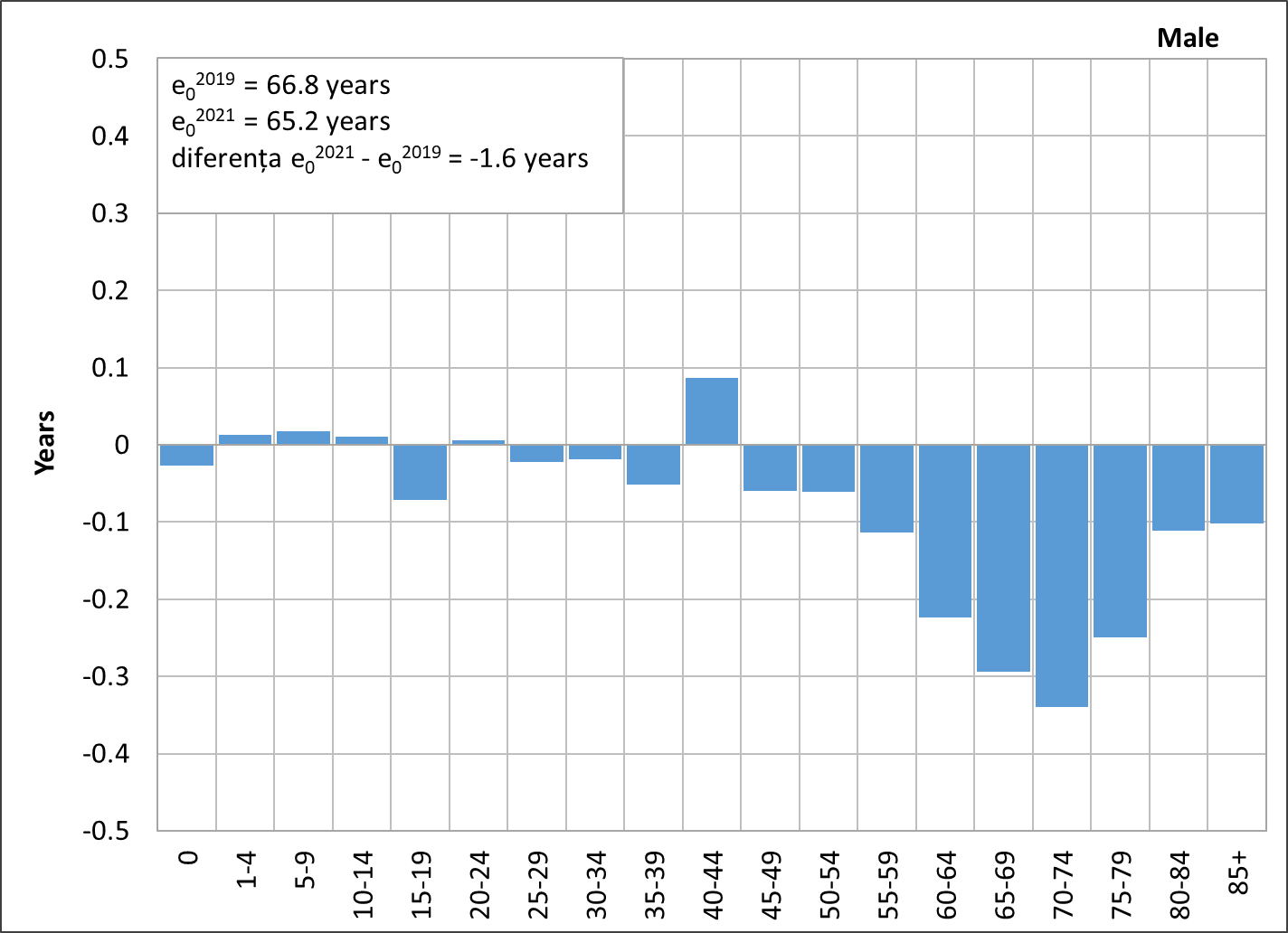


Fig. 5. The contribution of age groups to the formation of the difference in life expectancy
Source: Calculated based on NBS data
The summary difference in life expectancy between the years 2019 and 2014 is practically similar for both sexes; differences are present only in its distribution by age groups (Fig. 5). However, in the case of males, we are talking about a reduction in mortality in the group of young people 25-39 years, which later continues in the adult population and the young elderly, up to the age of 74. For the other age groups, we observe a stagnation of mortality. For females, mortality reductions were characteristic, especially for the adult and elderly population, without reaching the oldest old. However, in the case of females, the elderly group stands out more than the case of males.
The next stage of comparison, 2021 and 2019, the one devoted to the pandemic period, practically demonstrates a similar structure of changes in mortality between sexes with the only difference in intensity. However, for ages 0-44, the mortality level remained unchanged between 2019-2021. The increase in mortality has affected the elderly population. For the adult population, in the range of 45-59 years, an increase in mortality is also noticed but relatively moderate. The increases became more pronounced starting from the age of 60, increasing gradually and reaching the maximum increase at the age of 70-74 and then with a decrease towards the most advanced ages.
DISCUSSIONS
The analysis demonstrated that the Covid-19 pandemic had a disastrous impact on mortality trends that used to be stable in previous years. The available data do not allow us a much deeper analysis. However, the direct impact of the pandemic was undoubtedly quite strong – the number of deaths from Covid-19 led to a substantial increase in the annual number of deaths.
It is important to note that the deaths due to Covid-19 presented by the Ministry of Health on the official page refer only to deaths confirmed by a positive clinical test for the presence of the Covid-19 infection (Penina, 2021). Other countries affected by the Covid-19 pandemic have also reported deaths from Covid-19, including suspected cases that were not confirmed by a clinical test regarding the presence of the infection. In the interview given by the researchers - Garcia et al. – in 2021, they mentioned that the approach of an inclusive and suspicious death registration model would have increased by 30% the number of Covid-19 deaths recorded in some countries (Garcia, et al., 2021). The existing data on the number of deaths due to Covid-19 currently available for Moldova do not allow the verification of such hypothesis. However, precisely from this perspective, the evolution of mortality in Moldova during this period is of significant interest. From this perspective, the deaths that occurred as a result of complications - here it is important to emphasize that only 6% of deaths due to Covid-19 were not characterized by any comorbidities (the author's observations based on primary data) - or post-Covid-19 sequelae could be attributed other causes of death. However, the structural changes observed in the trends of the major causes of death and certain specific causes demonstrate their atypical evolution. Analyzes carried out at the international level highlight the impact of the Covid-19 pandemic, through possible complications or sequels, on the population's health level. However, this determines the possible appearance of respiratory, cardiovascular, neurological, or digestive complications (Yang, et al., 2021). This statement is only a hypothesis, the confirmation of which requires much deeper analysis and more complex data.
An indirect confirmation of the impact of the Covid-19 pandemic on mortality transformations during the pandemic period is brought by the age contribution in the formation of life expectancy in the 2019-2021 interval. Previous research on Covid-19 mortality indicates a synchronous distribution of Covid-19 deaths by both sexes and age groups, with the distribution observed for overall mortality (Pahomii, 2020; Penina, 2020; Pahomii, 2021). Such similar profiles in terms of changes in mortality for the sexes indicate a situation that exceeds a usual framework of the evolution of mortality, traditionally age profiles for the sexes being more heterogeneous.
A very worrying aspect highlighted during the pandemic period, both in the first and the following year, is the impact on the young elderly groups more than the very old (oldest-old). A similar situation is observed at the international level, however, the reduction of life expectancy in most countries was explicitly determined by the increase in mortality in the 60-79 age group (Aburto, et al., 2022).
International practice demonstrates that periods of increased mortality are followed by recovery periods. However, the pace and level of recovery are determined mainly by the general population's health level. More accurate conclusions on this subject could be drawn based on the data for the year 2022 when they will be available.
The impact of the Covid-19 pandemic on mortality, but also on the health of the population, is much more complex and probably even under-appreciated in the national context. The deep study of the situation would allow the derivation of effective and prompt responses to improve the impact of the Covid-19 pandemic on the subsequent evolution of mortality.
CONCLUSIONS
The Covid-19 pandemic caused a substantial increase in the number of deaths, also leading to a significant decrease in life expectancy in both sexes. Additionally, during the pandemic, an increase in RSM due to diseases of the cardiovascular system and diseases of the respiratory system and RSM due to infections was observed. It is important to note that the data presented by the NBS regarding the major cause of death – infectious diseases – do not include deaths due to Covid-19. The more detailed analysis of the major causes of death that registered increases during the pandemic period - diseases of the cardiovascular system and diseases of the respiratory system - showed an increase in mortality due to coronary atherosclerosis and acute pneumonia, contrary to the trends existing in the pre-pandemic period.
The analysis of the contribution of change in the mortality level by age groups in the formation of the difference in life expectancy during the pandemic period (2019–2021) is quite similar for both sexes, referring only to a different intensity of changes rather than essential discrepancies by sex.
All these transformations indicate the direct or indirect impact of the Covid-19 pandemic on the mortality change.
REFERENCES
Aburto, J. M., Schöley, J., Kashnitsky et al. (2022). Quantifying impacts of the COVID-19 pandemic through life-expectancy losses: a population-level study of 29 countries. International Journal of Epidemiology, 51(1), 63-74. https://doi.org/10.1093/ije/dyab207 0
Andreev, E. M. (1982). Metod komponent v analize prodolzhitel'nosti zhizni. Vestnik statistiki, 9, 42-47.
Bauer, R., Speringer, M., Fruhwirt, P., Seidl, R., & Trautinger, F. (2022). Assessing excess mortality in Vienna and Austria after the first year of the Covid-19 pandemic. Vienna Yearbook of Population Research, 20(1), 393-414. https://doi.org/10.1553/populationyearbook2022.dat.1 https://www.austriaca.at/?arp=0x003d2f56
Eurostat (2013). Revision of the European Standard Population. Report of Eurostat's task force. Luxembourg: Publications Office of the European Union. https://data.europa.eu/doi/10.2785/11470
Garcia, J., Torres, C., Barbieri, M., et al. (2021). Differences in COVID-19 mortality: Implications of imperfect and diverse data collection systems. Population, 76(1), 35-72. https://doi.org/10.3917/popu.2101.0037, https://www.cairn-int.info/journal-population-2021-1-page-35.htm?contenu=article
Institut National D'études Démographiques (INED). In our researche's own words - Demographic fact sheets - All about population. https://www.ined.fr/en/everything_about_population/demographic-facts-sheets/researchers-words/
Islam, N., Jdanov, D. A., Shkolnikov, V. M., et al. (2021). Effects of covid-19 pandemic on life expectancy and premature mortality in 2020: time series analysis in 37 countries. British Medical Journal, 375, e066768. https://doi.org/10.1136/bmj-2021-066768
Kolk, M., Drefahl, S., Wallace, M., & Andersson, G. (2021). Excess mortality and Covid-19 in Sweden in 2020: a demographic account. Vienna Yearbook of Population Research, 20, 317-348. https://doi.org/10.1553/populationyearbook2022.res2.2.
Ministry of Health of Moldova. (2022, April 19). Covid-19. Communique. Retrieved from Ministry of Health. https://ms.gov.md/comunicare/112-cazuri-noi-de-covid-19-raportate-pentru-19-aprilie-2022/
Ministry of Health of Moldova. (2020, March 7). Retrieved from Covid-19. Communique. https://ms.gov.md/comunicare/comunicate/msmps-confirma-primul-caz-de-coronavirus-de-tip-nou-in-republica-moldova/
Ministry of Health of Moldova. (2020, March 18). Retrieved from Covid-19. Communique. https://ms.gov.md/comunicare/comunicate/republica-moldova-a-inregistrat-primul-deces-cauzat-de-noul-coronavirus/
Pahomii, I. (2021, 15-16 octombrie). Covid-19 associated mortality – from the first case to the latest available data. In: Creșterea economică în condițiile globalizării. Sesiunea științifică "Migrația și schimbări demografice: abordare interdisciplinară": conferința internațională științifico-practică (ediția a XV-a, pp. 96-103). Chișinău: INCE. https://doi.org/10.36004/nier.cdr.2021.15-
Pahomii, I. (2020, 23 octombrie). Regional aspects of COVID-19 mortality in Moldova. In: Implicațiile economice și sociale ale pandemiei COVID-19: analize, prognoze și strategii de atenuare a consecințelor = Economic and social implications of the COVID-19 pandemic: analysis, forecasts and consequences mitigation strategies: teze ale conferinței științifice internaționale (pp. 280-283). Chișinău: INCE. http://dspace.ince.md/jspui/handle/123456789/1107
Penina, O. (2020). Aspectele demografice ale sănătăţii populaţiei în Republica Moldova: tendinţe și perspective = Demographic aspects of population health in Moldova: trends and perspectives. Revista de Ştiinţe ale Sănătăţii din Moldova =Journal of Medical Science of Moldova, 25(3), 81-88. https://cercetare.usmf.md/ro/editia-speciala-revistei-de-stiinte-ale-sanatatii-din-moldova-dedicata-aniversarii-75-ani-nr-3-2020
Penina, O., Mesle, F., & Vallin, J. (2022). Mortality trends by causes of death in Moldova in the Republic of Moldova, 1965-2020. Chișinău: Medicina. https://library.usmf.md/sites/default/files/2022-04/PeninaMesleVallin_MortalityTrends.pdf
Penina, O. (2021). Temporal trends and patterns in COVID-19 mortality in Moldova. Economy and Sociology, 2, 85-93. https://doi.org/10.36004/nier.es.2021.2-07
Schöley, J., Aburto, J., Kashnitsky, I., Kniffka, M., Zhang, L., Jaadla, H., Dowd, J. B. & Kashyap, R. (2022). Life expectancy changes since COVID-19. Nature Human Behaviour, 6(12), 1649-1659. https://doi.org/10.1038/s41562-022-01450-3,
Ugarte, M., Achilleos, S., Quattrocchi, A., et al. (2022). Premature mortality attributable to COVID-19: potential years of life lost in 17 countries around the world. BMC Public Health, 22(54). https://doi.org/10.1186/s12889-021-12377-1
Yang, K., Wen, G., Wang, J., Zhou, S., Da, W., Meng, Y., Xue, Y. & Tao, L. (2021). Complication and sequelae of COVID-19: What should we pay attention to in the post-epidemic era. Frontiers in Immunology, 12, 711741. https://doi.org/10.3389/fimmu.2021.711741
Zarei, M., Bose, D., Nouri-Vaskeh, M., Tajiknia, V., Zand, R., & Ghasemi, M. (2022). Long-term side effects and lingering symptoms post COVID-19 recovery. Reviews in Medical Virology, 32(3). https://doi.org/10.1002/rmv.2289